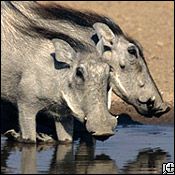Quck answer
The Desert Warthog is a subspecies of the common warthog and is found in the deserts of Namibia, Botswana, and South Africa. They have adapted to their harsh environment by having longer legs and a more slender build than their counterparts in other habitats. Their diet consists of roots, tubers, and bulbs, which they dig up with their strong snouts. Despite their fierce appearance, they are actually quite shy and will run away from danger rather than confront it. They are also important prey for larger predators such as lions and cheetahs.
Wild Animals

Desert Warthog, also known as Phacochoerus aethiopicus, is a species of pig that has wart-like growths up to 15 cm long on their eyes and under their jaws, which are believed to protect them from injuries that might occur when they fight. Female desert warthogs live in small family groups of 6 to 18, along with their offspring. On the other hand, male desert warthogs are usually solitary, but sometimes they form bachelor groups. Occasionally, several small groups come together to form a clan.
These diurnal vegetarians feed on grasses, seeds, roots, tubers, and bulbs. They also allow birds called oxpeckers to alight on their back and pick off parasites. Additionally, wallowing in mud helps them get rid of parasites while providing relief from the heat of the day.
Animal Facts
Name: Desert Warthog (Phacochoerus aethiopicus)
Family: Suidae (Pigs and Hogs)
Range: Sub-Saharan Africa
Habitat: Arid grassland, savanna, and open plains
Diet: Grasses and rhizomes
Head and Body Length: 3.6 to 4.6 feet (1.1 to 1.4 m)
Tail Length: 14 to 20 inches (35 to 50 cm)
Shoulder Height: 25 to 29.5 inches (64 to 75 cm)
Weight: 106 to 315 pounds (48 to 143 kg)
Life Cycle: Mating associated with rainy season; gestation 170 to 175 days, usually two to four young born
Description: Gray, wrinkled skin; enormous head; long snout; tusks; facial warts; long, dark mane; long, hairless body; long legs
Conservation Status: Common
FAQ
1. What is a Desert Warthog?
A Desert Warthog, also known as a Cape Warthog, is a species of pig that is found in the deserts of Africa. They are known for their distinctive appearance, with their large tusks and rough, bristly hair. Despite their name, they are not exclusively found in deserts and can also be found in savannas and other dry areas.
2. What do Desert Warthogs eat?
Desert Warthogs are omnivorous and eat a variety of foods, including grasses, roots, bulbs, and fruits. They also consume insects, small animals, and even the occasional carrion. Their tough snouts and tusks allow them to dig for roots and tubers, and they are able to survive in areas with little water by obtaining moisture from their food.
3. How do Desert Warthogs survive in the harsh desert environment?
Desert Warthogs have several adaptations that allow them to survive in the harsh desert environment. Their tough, bristly hair helps to protect them from the sun and the abrasive sand. They are also able to go without water for extended periods of time by obtaining moisture from their food. Additionally, they are able to regulate their body temperature by panting and seeking shade during the hottest parts of the day.
4. Are Desert Warthogs endangered?
Desert Warthogs are not currently considered endangered, but their populations have declined in some areas due to habitat loss and hunting. They are sometimes hunted for their meat, and their habitat is being destroyed by human development and agriculture. Conservation efforts are underway to protect their populations and habitats.
5. Do Desert Warthogs have any predators?
Desert Warthogs have several natural predators, including lions, hyenas, and leopards. They are able to defend themselves with their large tusks and by running at high speeds, but they are still vulnerable to predation. Young warthogs are particularly vulnerable and are often preyed upon by eagles, jackals, and other predators.





Leave a Reply